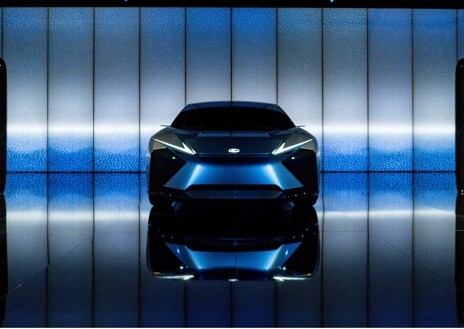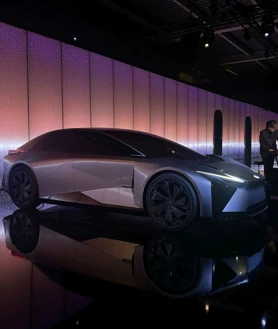Ten black totems that react when a person approaches flank the Lexus LF-ZC concept car that represents the future of the brand. The montage 'Time', designed by Hideki Yoshimoto, featuring music by composer Keiichiro Shibuya, and the installation '8 minutes and 20 seconds' by designer Marjan van Aubel, are on display at Milan Design Week until Sunday April, the 21st.
'Time' captures Lexus' vision of how software application and energy innovations will help cars of the future deliver new possibilities for customers and enable luxury to coexist with carbon neutrality.
The exhibition features the work of two designers inspired by the Lexus LF-ZC, a concept model that explores the possibilities that an electric vehicle (BEV) could offer. 'Beyond the Horizon', by Hideki Yoshimoto and his studio Tangent, captures a world of future mobility evolving through software innovation. Produced in collaboration with musician and composer Keiichiro Shibuya, the piece also immerses the visitor in light and sound.
On the outside of the ship is the installation '8 minutes and 20 seconds' (the time it takes for light to travel from the moment it leaves the Sun until it reaches the Earth), a work by designer Marjan van Aubel that incorporates the design and technology in search of a carbon-neutral future.
Beyond the totems of more than two meters and the giant screen (4 meters high by 30 meters wide) made with 'Time' Echizen 'washi' paper, which constantly shows changing views of the horizon, the protagonist is the model that will inspire the future of Lexus cars, the LF-ZC.
At the Kenshiki forum held in December last year in Brussels, Lexus provided details on its roadmap to become a 100% BEV (Battery Electric Vehicle) brand worldwide by 2035, and even sooner. in Europe, in 2030 if market conditions allow.
THE LF-ZC –Lexus Future Zero-emission Catalyst, or Lexus Future Zero-emission Catalyst–, debuted at the European level at that Kenshiki forum. A new sedan is planned to be built on this concept-car that will go into production in 2026.
Beyond its electric mechanics and futuristic lines, what is truly revolutionary is the soul of this future vehicle. It will be the first car capable of reading the driver's mood and adapting driving behavior to what it perceives from the person behind the wheel.
To achieve this, the Japanese brand has developed a new operating system called Arene. This software will change the way the vehicle feels and behaves in different driving modes. The driver can raise the level of the sensory experience by changing the sound and vibrations of the vehicle.
The driver's environment will be completely immersive and fully digital, allowing quick access to all controls. The most prominent feature is a yoke-type steering wheel to control Lexus' exclusive One Motion Grip steering-by-wire technology. The functions are grouped on small digital screens on both sides of the driver.
Operational controls, such as gear shifts, safety features and driver assistance systems (ADAS), as well as driving mode selection, are located on the left, while more practical controls, such as audio, the climate control, telephone and AI functions are grouped on the right. The prototype is also equipped with digital mirrors, both inside and outside, as well as a panoramic monitor on the front passenger side, to access entertainment and mobility applications.
Lexus' new Arene operating system will open up new entertainment and connectivity opportunities. Using artificial intelligence –AI–, the voice recognition system reacts quickly to instructions and will be able to offer flexible and personalized suggestions, just like a personal butler would. The system will even be able to learn the driver's routines, as well as their preferred applications and functions, and activate them automatically, without having to ask for it.
Upcoming Innovative Lexus Models
FP


Upcoming releases
In the near future, between now and 2026, Lexus will maintain its multi-technology approach to electrification, based on three types of vehicles: models that offer multiple engine options, such as the UX, NX and RX SUVs; BEVs derived from Lexus' current global architecture platform, such as the RZ; and BEVs produced using Gigacast on a new generation platform, such as the future model based on the LF-ZC prototype. In the coming years, vehicles in each of those three categories, including electric, will be introduced to expand and diversify Lexus' offering.
They will also incorporate advances in motors and continuous improvements in battery technology. Lexus will be the first brand to adopt new battery technologies, including a high-performance lithium-ion battery that is expected to be able to recharge to 10 to 80 percent in about 20 minutes and have a range of about 800 km. (WLTP cycle).
A lower cost battery will also be offered, so that the customer has more options.
In spring 2024, the RZ range will grow with the inclusion of a new front-wheel drive version. Later, the One Motion Grip steering-by-wire option will be offered for the first time.
Also planned for later is a system that replicates the feel and operation of a manual transmission in battery electric vehicles, a new dimension in Lexus' mission to prioritize driving pleasure. From the outside, the vehicle will be as quiet as any other BEV, but at the controls, the driver will experience all the sensations of a vehicle with a manual transmission, including the sound and vibrations of the engine.
#car #adapts #driver39s #mood #reality #truth